The conflict between Gaza and Israel is one of the most talked-about and heartbreaking struggles in the modern world. It’s a story that has lasted for decades — filled with history, politics, loss, and the yearning for peace. While governments and global powers debate solutions, the real impact is felt by ordinary people on both sides — families who just want safety, children who want to grow up without fear, and communities who dream of a future beyond violence.
Understanding this conflict means looking beyond the headlines. It’s about seeing the human cost and the complex history that shapes each decision, border, and reaction.
—
The History Behind the Divide
The roots of the Gaza–Israel conflict go back to the mid-20th century, when the region known as Palestine was divided after the end of British control. In 1948, the State of Israel was created, sparking war between the new nation and several neighboring Arab countries. Many Palestinians were displaced during this time — an event they remember as the Nakba, or “catastrophe.”
In the years that followed, conflicts over land and sovereignty continued. The Gaza Strip, a small coastal area about 25 miles long, became home to more than two million Palestinians. Israel withdrew its troops and settlers from Gaza in 2005, but it has maintained control over its borders, airspace, and maritime access.
The militant group Hamas has governed Gaza since 2007, after winning elections and taking control from the Palestinian Authority. Israel, the United States, and the European Union consider Hamas a terrorist organization due to its attacks on Israeli civilians. Since then, the two sides have engaged in repeated cycles of violence — rocket fire, airstrikes, and ground operations — leaving deep scars on both populations.
—
Life Inside Gaza
For the people living in Gaza, daily life is often difficult. The area faces blockades that restrict the movement of goods and people, leading to shortages of food, medicine, and clean water. Electricity is often limited to just a few hours a day. Many young people in Gaza have never left the territory, and unemployment rates remain among the highest in the world.
Despite these hardships, there’s still remarkable resilience. People continue to build, teach, and dream. Artists, teachers, and doctors work tirelessly to create hope amid the chaos. Families try to hold on to normal routines — children attend school, weddings still happen, and communities continue to come together in acts of faith and survival.
—
Life in Israel
Across the border, Israeli civilians also live under constant tension. Many communities near Gaza face rocket attacks that force them into shelters at a moment’s notice. Children grow up knowing the sound of sirens and practicing emergency drills.
Israel’s citizens live with the fear that violence could erupt at any time. At the same time, they also live in a vibrant democracy — a country with a strong economy, modern cities, and a diverse population that includes Jews, Arabs, Christians, and Druze communities. Many Israelis want peace and security just as much as Gazans do.
—
The Role of the World
The international community has long tried to mediate between the two sides. The United Nations, the United States, and regional powers like Egypt and Qatar have all been involved in ceasefire talks and humanitarian efforts. Yet, long-term peace has remained elusive.
One of the biggest challenges is trust. Decades of conflict have left both sides wary and deeply wounded. Every act of violence — whether a rocket strike or an air raid — makes it harder to rebuild that trust. But peace cannot come without dialogue, understanding, and accountability.
The world continues to call for solutions that respect human rights, ensure security, and promote justice for both Israelis and Palestinians. While leaders argue over politics, humanitarian organizations on the ground — such as the Red Cross, UNICEF, and local NGOs — focus on saving lives and delivering aid.
—
The Human Perspective
When we look beyond borders and politics, one truth becomes clear: the pain is shared. On both sides are parents who want their children to sleep safely, students who want to study, and workers who want to build better lives.
In times of violence, images from Gaza and Israel fill the news — destroyed homes, crying families, overcrowded hospitals. But behind every image is a person with dreams, memories, and a desire for peace. It’s easy to take sides; it’s harder to remember that every life matters.
That’s why stories of solidarity and compassion are so powerful. Israeli doctors treating Palestinian children, or Gazans sending messages of peace — these moments remind us that humanity still exists even in the darkest times.
—
Searching for Peace
True peace will not come from weapons or walls; it will come from understanding. Both sides must be willing to see each other as human beings, not enemies. The world must support efforts that focus on rebuilding lives, creating opportunities, and healing old wounds.
The road to peace is long, but not impossible. As long as there are people who continue to hope — mothers, teachers, young activists, and peacebuilders — there is a chance for a better tomorrow.
The story of Gaza and Israel is more than just a conflict; it’s a test of humanity’s ability to learn, forgive,
